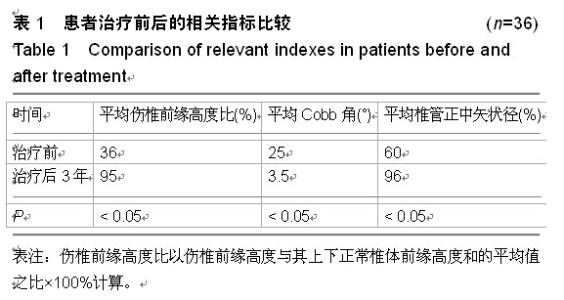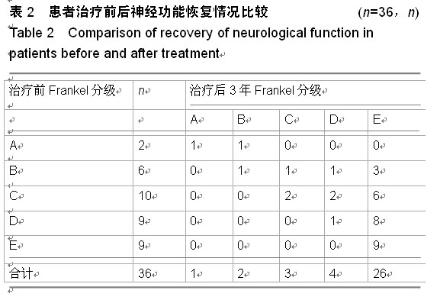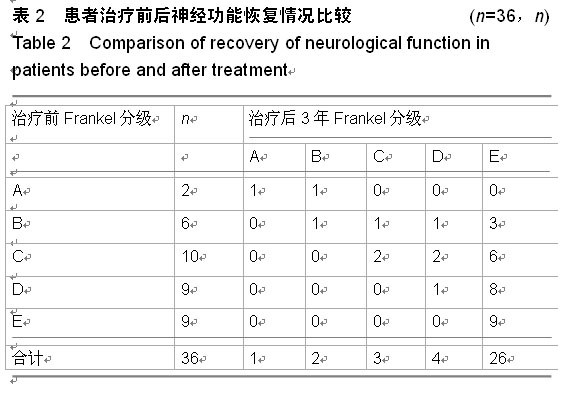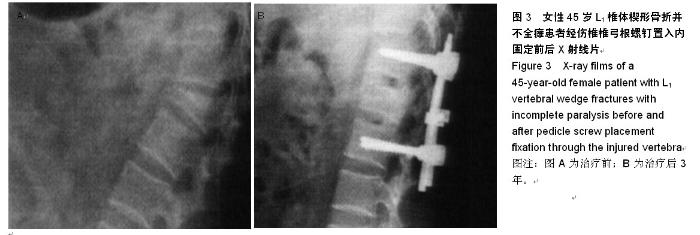| [1] 张文武,申勇,姚晓光,等.后路长节段椎弓根螺钉固定治疗胸腰椎骨折的疗效评价[J].中国矫形外科杂志,2014,22(6):487-492.
[2] 李超,吴大江,谢杨,等.经伤椎短钉置钉后路复位内固定治疗单节段压缩性胸腰椎骨折[J].第二军医大学学报,2014,35(2):216-220.
[3] 黄纯聪,初同伟. 43例后路伤椎置钉治疗胸腰椎骨折的临床观察[J].第三军医大学学报,2014,36(6):613-615.
[4] 李志良,杨操,熊期,等. Sextent系统下微创经皮与开放椎弓根螺钉内固定术治疗胸腰椎骨折疗效比较的Meta分析[J]. 中国矫形外科杂志,2014,22(8):687-691.
[5] 王海,贺小兵,王明贵,等.经椎旁肌间隙入路治疗52例胸腰椎骨折[J].重庆医学,2014,43(13):1557-1559.
[6] 李长青,张伟,常献,等.小切口减压结合经皮椎弓根螺钉内固定治疗伴神经功能损害的胸腰椎骨折[J].中国脊柱脊髓杂志,2014,24(5):395-399.
[7] 王福贵,娄颜伟,陈伟.经伤椎单侧置钉短节段内固定治疗胸腰椎骨折的效果[J].江苏医药,2014,40(13):1548-1550.
[8] 徐烁,党小伍,肖建春,等. Quadrant通道下微创手术治疗胸腰椎骨折的临床分析[J].中国临床解剖学杂志,2014,32(4):471-475.
[9] 龙浩,肖杰,邹伟,等,后路伤椎单侧椎弓根置钉结合钉棒系统复位固定治疗胸腰椎骨折[J].中国现代医学杂志,2014,24(27):59-62.
[10] 孟祥玉,曾凯斌,吐尔洪江•阿布都热西提,等. Wiltse入路结合非融合技术治疗胸腰椎骨折疗效分析[J].中国修复重建外科杂志,2014,28(9):1105-1108.
[11] Radcliff KE, Reitman CA, Delasotta LA, et al. Pulmonary cement embolization after kyphoplasty: a case report and review of the literature. Spine. 2010;(10):1298-1299.
[12] Palmisani M, Gasbarrini A, Barbanti Brodano G, et al. Minimally invasive percutaneous fixation in the treatment of thoracic and lumbar spine fractures. Eur Spine J. 2013;(1): 353-355.
[13] 汪来杰.短节段椎弓根螺钉置入内固定修复胸腰椎爆裂性骨折:椎体稳定性1年随访[J].中国组织工程研究,2014,18(44): 7106- 7110.
[14] 成平,李秀成,宋爱国.经伤椎短节段椎弓根钉内固定治疗胸腰椎爆裂骨折的疗效体会[J].中国骨与关节损伤杂志, 2012, 27(3): 231-232.
[15] 沈宁江,林明侠,林庆彪,等.国产通用型脊柱内固定系统治疗胸腰椎爆裂骨折[J].中国骨与关节损伤杂志,2010, 21(12):122-125.
[16] 马超.胸腰段脊柱爆裂性骨折椎体后缘骨块占位大小与手术中骨块复位方式的相关研究[D].山东中医药大学,2011.
[17] Eno JJ,Chen JL, Mitsunaga MM. Short same-segment fixation of thoracolumbar burst fractures. Hawaii J Med Public Health.2012;71(1):19-22.
[18] 孟晋.经椎弓根椎体内植骨治疗胸腰椎爆裂性骨折疗效观察[D]. 延安大学, 2013.
[19] 潘建宏,郭永良,惠华,等.经伤椎椎弓根椎体植骨短节段内固定治疗胸腰椎爆裂骨折[J].中国骨与关节损伤杂志,2012,51(3): 237-238.
[20] 陈康.短节段椎弓根内固定治疗胸腰椎爆裂骨折42例临床分析[J].中国医药指南,2013,28(42):70-71.
[21] 叶少奇.短节段椎弓根内固定配合接骨药丸治疗胸腰段爆裂骨折的疗效观察[D].福建中医药大学,2012.
[22] 顾华,付建,易难,等. AF椎弓根螺钉内固定系统治疗胸腰椎爆裂性骨折:30个月随访的中远期效果分析[J].中国组织工程研究, 2012,16(27):2378-2381.
[23] 赵辉,柏涛,纳强,等.后路经伤椎短节段椎弓根钉内固定治疗胸腰椎爆裂性骨折[J].云南医药,2013,42(1):24-26.
[24] 刘建宏.经后路短节段椎弓根内固定治疗胸腰椎爆裂型骨折的远期疗效[J].中国高等医学教育,2012,2(14):139-140.
[25] 侯建思.椎弓根钉内固定治疗胸腰椎爆裂性骨折60例临床疗效观察[J].当代医学,2013,19(10):83-84.
[26] 汪勇刚,许永涛,徐林军.短节段椎弓根钉固定联合椎体成形术治疗胸腰椎爆裂性骨折[J].中外医疗,2014,33(1):64-66.
[27] 王洪伟,李长青,周跃.胸腰椎骨折伤椎椎弓根钉内固定技术研究进展[J].脊柱外科杂志,2010,8(1):52-55.
[28] 梁伟之,张海波,贾俊峰,等.椎弓根钉置入治疗胸腰椎骨折[J].中国组织工程研究,2012, 16(44):8308-8315.
[29] 胡海刚,王清,谭伦.伤椎椎弓根置钉植骨治疗胸腰椎骨折的应用现状及进展[J].中国组织工程研究,2012,16(48):9074-9078.
[30] 郝刚,孙天胜,李绍光,等.短节段椎弓根螺钉置入内固定治疗胸腰椎骨折[J].中国组织工程研究,2012,16(39): 7237-7241.
[31] Khoueir P, Oh BC, Wang MY. Delayed posttraumatic thoracolumbar spinal deformities: diagnosis and management. Neurosurgery. 2008;63(3 Suppl):117-124.
[32] Gelb D, Ludwig S, Karp JE, et al. Successful treatment of thoracolumbar fractures with short-segment pedicle instrumentation. J Spinal Disord Tech. 2010;23(5):293-301.
[33] 吴怀宝,刘志富,吴叶.短节段金属植入物固定并经椎弓根植骨治疗胸腰段单节段骨折27例:随访效果评价[J].中国组织工程研究与临床康复,2010,14(13):2433-2436.
[34] 李家谋,张坤亚,韩伟峰,等.短节段椎弓根螺钉置入内固定椎体成形治疗胸腰椎骨折的生物力学检测[J].中国组织工程研究与临床康复,2011,15(39):7284-7287.
[35] Liao JC, Fan KF, Chen WJ, et al. Transpedicular bone grafting following short-segment posterior instrumentation for acute thoracolumbar burst fracture. Orthopedics. 2009;32(7):493.
[36] 于长水, 杨卫良. 经伤椎椎弓根螺钉置入内固定治疗胸腰椎骨折[J].中国组织工程研究与临床康复,2010,14(48):9065-9068.
[37] 范志丹,夏虹,昌耘冰,等.伤椎传统短节段椎弓根螺钉固定与附加椎弓根螺钉固定后椎体生物力学稳定性的比较[J].中国组织工程研究与临床康复,2008,12(26):5011-5014 .
[38] Wang XY, Dai LY, Xu HZ,et al. Kyphosis recurrence after posterior short-segment fixation in thoracolumbar burst fractures. J Neurosurg Spine. 2008;8(3):246-254.
[39] Yang JY, Lee JK, Song HS. The impact of adjacent segment degeneration on the clinical outcome after lumbar spinal fusion. Spine (Phila Pa 1976). 2008;33(5):503-507.
[40] 陈文扬. 经伤椎分别置入单向与万向椎弓根螺钉内固定治疗胸腰椎骨折的比较[D].广西医科大学,2014.
中国组织工程研究杂志出版内容重点:人工关节;骨植入物;脊柱;骨折;内固定;数字化骨科;组织工程
|





